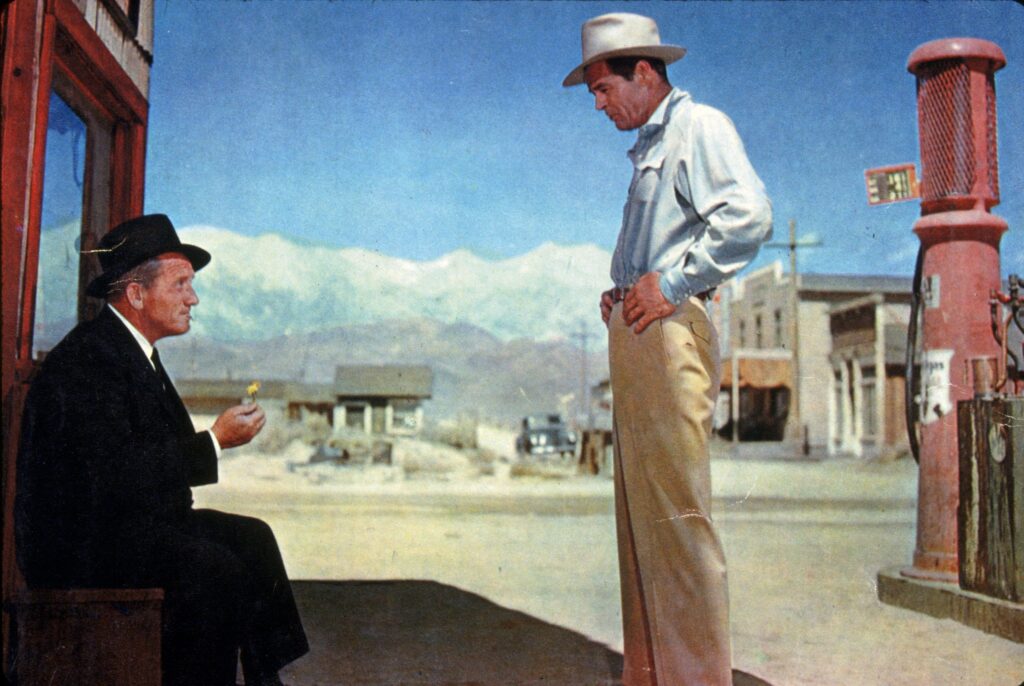This was written as the introduction for the Mesilla Valley Film Society’s screening of Bad Day At Black Rock in July, 2024.

You might be wondering why we’re showing a film bathed in blinding sunlight and vivid Eastman color on our usual noir night. Well, first of all, it’s because I pick the movies. Secondly, because this movie’s got something to say, something distinctly dark about not just the people you’ll see on screen, but about this country and its legacy.
Released in 1955 by Metro-Goldwyn-Mayer and filmed in glorious CinemaScope, this isn’t your typical shadowy thriller. But don’t let the panoramic vistas fool you – this flick packs a noir-tinged punch that’ll leave you breathless.
Picture this: a tiny ramshackle town baking under a merciless southwestern sun, somewhere between Phoenix and Los Angeles. It’s one of those places that’s barely on the map, a blip where the train never stops – until today. When a black-suited stranger with one arm steps off onto that dusty platform, things are never going to be the same in Black Rock.
That probably sounds a lot like a Western, but Bad Day at Black Rock is a one of a kind, multi-genre masterpiece that’s part Western, part war movie, and yes, part film noir. Set in 1945, it uses the weight of the recently concluded war and America’s actions against some of its own citizens to great effect.
This film boasts some serious pedigree. It snagged three Oscar nominations – Best Adapted Screenplay, Best Director, and Best Actor. And speaking of actors, we’ve got a powerhouse cast led by the incomparable Spencer Tracy, with Robert Ryan, Walter Brennan, Lee Marvin, and Ernest Borgnine rounding out an ensemble that’s nothing short of spectacular.
The story behind the making of this film is almost as fascinating as the movie itself. It started life as a short story by Howard Breslin, caught the eye of actor-turned-writer Don McGuire, and eventually landed on the desk of MGM’s production chief Dore Schary. Schary saw echoes of his earlier hit “Crossfire” – both films unfolding over 24 tense hours, both revolving around men protecting an ugly secret.
You might think an actor of Spencer Tracey’s caliber would jump at the chance to star in a movie like this, but that wasn’t the case at all. In fact, Tracy initially hated the script. He felt the role of John J. Macreedy lacked character, especially since Macreedy was a man of few words. Additionally, at 54 years old, Tracy also felt he was too old for the part – and he wasn’t wrong, really. After all, the film was set to shoot in Lone Pine, California, where temperatures could soar past 100 degrees, and he’d be wearing a suit the whole time. On top of that, Katherine Hepburn had ordered him to stay off the bottle while working.
You can’t blame the guy for thinking he’d rather kick back in Palm Springs with a G&T, can you?

However, producer Dore Schary had a couple of tricks up his sleeve. First, he told the screenwriter to add a gimmick to the character that he knew Tracy couldn’t resist – Macreedy would have only one arm. Then, in a brilliant bit of Hollywood maneuvering, Schary told Tracy that Alan Ladd had already agreed to play the part. If you know anything about how Hollywood worked in the fifties, you won’t be surprised to hear that Alan Ladd hadn’t even heard of the movie.
Suddenly, Tracy’s tune changed. The challenge of playing a one-armed character was too intriguing to pass up. But the drama didn’t end there. Tracy didn’t get along with the original director, Richard Brooks, so John Sturges got the directing gig instead. Tracy had enjoyed working with Sturges the previous year on The People Against O’Hara and the two hit the ground running. Tracy ended up delivering a performance so powerful it earned him an Oscar nomination. Like Marlon Brando in The Godfather, this goes to show that sometimes the roles actors are most hesitant about can turn out to be their greatest triumphs.
Coincidentally, Spencer Tracy lost the Oscar for Best Actor to co-star Ernest Borgnine, who absolutely blew the doors off in Delbert Mann’s working-class romantic drama Marty the same year.

No discussion of Bad Day at Black Rock would be complete without mentioning the formidable Robert Ryan. A titan of noir cinema, Ryan brings his trademark intensity to the role of Reno Smith, the town’s menacing unofficial leader. Ryan was no stranger to complex, often violent characters, having cut his teeth in the 1949 boxing picture The Set-Up, where he delivered a gut-wrenching performance as a washed-up prizefighter. Three years later, he’d portray a volatile cop in the gritty winter noir On Dangerous Ground, which you might have seen in this very theater a while back. In Bad Day at Black Rock, Sturges uses Ryan’s steely gaze and simmering rage as the perfect counterpoint to Tracy’s stoic determination. It’s a masterclass in screen tension, with Ryan embodying the dark heart of a town harboring terrible secrets.
On top of the Oscar nominations, the movie saw love from the British Academy Film Awards, Cannes, the Directors Guild of America Awards, and it ended up fourth in the the National Board of Review’s Top Ten films of 1955. The studio and the producers were happy with it, too; it made three times its budget back.
So, as you prepare to watch “Bad Day at Black Rock,” keep in mind the behind-the-scenes struggles and triumphs that went into bringing this unique film to life. It’s a testament to the power of clear, concise storytelling, tight editing, and trusting a cast of professionals to carry that weight.
Leave a Reply